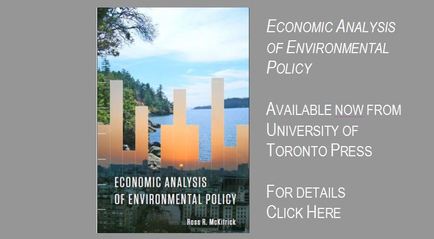
|
|
NEWEST ITEMS
|
ECONOMIC IMPLICATIONS OF A PHASED-IN EV MANDATE IN CANADA
I have a new paper forthcoming in the Canadian Journal of Economics:
The pre-print version is at the link. I'll post the journal link once the paper has gone through the proofs stage. The key message is that an EV mandate is only affordable if it is also unnecessary. If you have to force people to switch to EVs the policy will push the auto sector into permanent losses. The key question is the pace at which EVs achieve cost parity. "Cost parity" doesn't just mean being able to buy an EV sedan for $30k. It means that across all vehicle classes, taking account of all purchase, maintenance and fuel costs, people are completely indifferent between EVs and internal combustion engines (ICEVs); analogous to the switch from LPs to CDs. If we reach cost parity by 2035 the mandate will be very costly but the economy will return to trend and the auto sector will probably survive albeit shrunken. But in that case the mandate is unnecessary. If cost parity takes longer and the mandate forces involuntary switching, the economic costs get very large very quickly and the auto sector goes into permanent losses. I simulate the outcome assuming 2050 cost parity and find the auto sector gets wiped out and the macroeconomic impacts are very painful. For the reasons stated in the paper I don't think it is realistic to expect EV cost parity by 2035, so my expectation is for the latter scenario. |
JUNE 14,2024 THE EV MANDATE WILL LIKELY DESTROY THE AUTO SECTOR IN CANADA |
RECENT ITEMS
Newspaper Columns, Commentary and OtherSOME RECENT NEWSPAPER OP-EDS
COMPLETE LISTING HERE April 2, 2024 Economists’ letter misses the point about the carbon tax revolt financialpost.com/opinion/carbon-tax-economists-letter-misses-point March 19, 2024 Western societies must stop the spread of Marxism financialpost.com/opinion/western-societies-must-stop-spread-of-marxism February 15, 2024 Canada's Eagle Pass symbolizes unity, America's exemplifies crisis financialpost.com/opinion/canada-eagle-pass-symbolizes-unity-america-exemplifies-crisis June 15, 2023 The truth about forest fires goes up in climate change smoke https://financialpost.com/opinion/truth-about-forest-fires-up-in-climate-change-smoke May 25, 2023 The Social Cost of Carbon Game financialpost.com/opinion/junk-science-week-social-cost-of-carbon-game April 12, 2023 The important climate study you won't hear about financialpost.com/opinion/ross-mckitrick-the-important-climate-study-you-wont-hear-about TEMPERATURE TRENDS IN CANADA SINCE 1888
We hear a lot about climate change. Would someone who lived in, say, 1918 notice much change in the average weather conditions compared to today? Once you delve into temperature data you will see that it's very hard to offer a simple answer to such a question. Patterns vary over time, by season and by place. For those Canadians who are curious about how the climate might have changed near where they live, I have written a rather lengthy report on the subject.
Or rather, I wrote an R program that generated a lengthy report. I analyze long term records on monthly average daytime highs in Canada, in various segments based on collections of stations available back 40, 60, 80, 100 and 130 years. There are also some nice graphs. If you think you know what "climate change" looks like in Canada, now you can test your perceptions against the data. The R program is here. 
Yourenvironment.ca
The idea of this site is very simple: to build the complete environmental record of every community across Canada. The site currently shows air emissions by source (back to 1990), air contaminant levels (back to 1974), monthly average high temperatures (back to 1900) for hundreds of places across the country, and water pollution records for several provinces. The layout is self-explanatory and it's very easy to use. The data are all from government agencies, but most of it has not hitherto been disseminated in a usable form to the public. All my sources are linked and the data I use are easily-downloadable. So the next time you find yourself in a conversation about some aspect of the environment and you wonder what is actually going on, look at yourenvironment.ca to find out. |
Recent Journal Articles and Discussion PapersTLS OVERSTATES CLIMATE FINGERPRINTING COEFFICIENTS WHEN FORCING SIGNALS ARE NEGATIVELY CORRELATED
I have published a paper in Environmetrics which goes deeper into problems with Total Least Squares (TLS), a popular regression estimation method in the "optimal fingerprinting" field in climatology.
I have written up an explanatory essay at Judith Curry's Climate Etc. blog. Briefly, there's a problem in regression analysis when your explanatory variables are measured with error. This causes ordinary least squares to underestimate the slope coefficients. The usual remedy in econometrics is called Instrumental Variables (IV), but climatologists instead adopted another technique called Total Least Squares (TLS). The trouble is, while we can prove IV yields asymptotically unbiased results, you can't prove that TLS works without making some strong assumptions that can't be tested. I show that in typical applications in climatology TLS imparts positive upward biases to the results and overstates the slope coefficient estimates. COSTS AND BENEFITS OF PHASING OUT GAS IN ONTARIO'S ELECTRICITY SECTOR
I have published a report for Canadians for Affordable Energy which looks at the proposal to phase out the use of natural gas in our power sector.
My report addresses some common misconceptions. First of all our power system is already remarkably clean. Second, power production needs to be matched to demand on a minute-by-minute basis, and this requires more than just baseload sources, it requires some rapidly scalable, dispatchable sources. Intermittent renewables are superfluous and we could do without them, but since we have them we also need dispatchable sources to offset their fluctuations. The costs of phasing out gas includes increased blackout risk since gas is our only dispatchable option. My report generates economy-wide cost numbers associated with IESO's proposed implementation scenarios and shows that this would be a serious and long lasting negative shock to Ontario's economy. CANADA'S PROPOSED BUILDING ENERGY EFFICIENCY TARGETS SHOULD BE SCRAPPED
Canada's Proposed Building Energy Efficiency Requirements, part of its GHG Emission Reduction Plan, will require all new homes to be 65% more energy efficient compared to 2019 by 2030, and commercial buildings 59%. In a 2023 report for the Fraser Institute I argue that this is a grotesquely inefficient form of climate policy.
I show that the proposed rules will boost home-building costs by about 8%, they will have very little effect on GHG emissions, and any reductions achieved will cost about 50 times the value of the carbon tax, making them very cost ineffective. At a time when we face a serious crisis of housing affordability this is a particularly bad policy idea, although the policy would be stupid even without the housing crisis. ADAPTATION SHOULD BE A HIGHER PRIORITY IN CLIMATE POLICY
I have published a paper through the MacDonald-Laurier Institute discussing why climate policy should be oriented more towards adaptation than mitigation.
I discuss why adaptation was considered a controversial option 20 years ago and remains so today, yet mitigation is largely a costly failure and adaptation has proven successful and relatively inexpensive. Moreover I argue that we are going to have to adapt anyway, so we need to judge carefully if mitigation policies actually impede effective adaptation. There's a choice to be made, you can't necessarily make a priority of both. |
Proudly powered by Weebly
